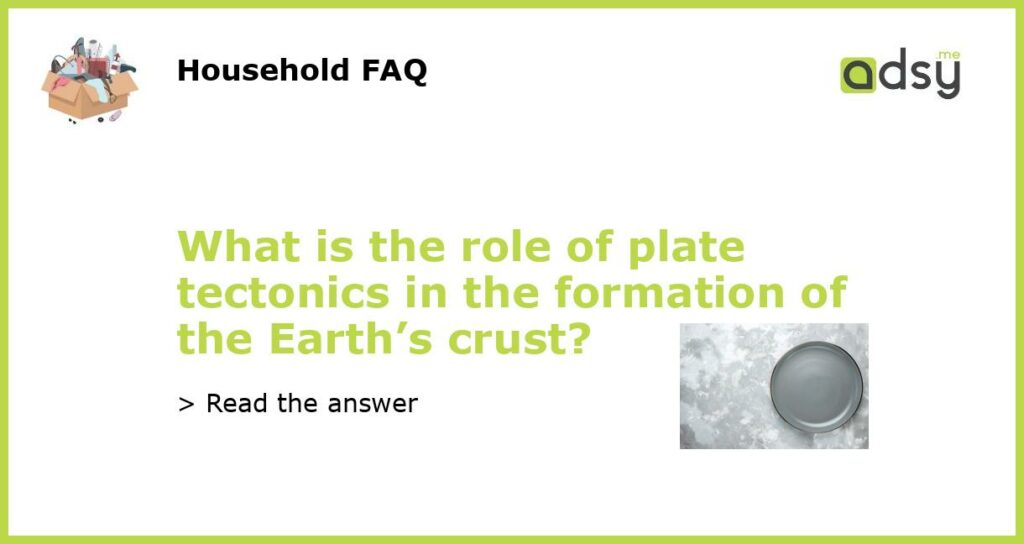The Role of Plate Tectonics in the Formation of the Earth’s Crust
Plate tectonics plays a crucial role in the formation and evolution of the Earth’s crust. This geological process involves the movement and interaction of large pieces, or plates, of the Earth’s lithosphere. The movement of these plates can result in the creation of new crust, the deformation of existing crust, and the formation of various geological features such as mountains, earthquakes, and volcanic activity. Understanding the role of plate tectonics is essential for comprehending the dynamic nature of our planet’s surface.
How Do Plate Tectonics Work?
Plate tectonics is driven by the convection currents in the Earth’s mantle, which is the layer beneath the crust. The phrase “continental drift” was used to describe the concept of moving continents before the theory of plate tectonics was fully established. It was not until the mid-20th century that the scientific community embraced the idea that the Earth’s lithosphere is made up of several large and smaller plates that are constantly moving.
These tectonic plates are composed of both continental and oceanic crust. The plates interact along their boundaries, which can be categorized into three main types: convergent, divergent, and transform boundaries. Convergent boundaries occur when two plates collide, divergent boundaries form when two plates move apart, and transform boundaries are created when two plates slide past each other horizontally.
Creation of New Crust
One of the significant roles of plate tectonics in the formation of Earth’s crust is the creation of new crustal material through seafloor spreading. At divergent boundaries, such as the mid-Atlantic Ridge, magma rises from the mantle and creates new crust as it cools and solidifies. This process continually adds new material to the oceanic crust, expanding the size of the plates.
As new crust forms, it moves away from the divergent boundary, pushing the existing crust aside. Over time, this movement can cause the oceanic crust to collide with a continental plate, leading to subduction. Subduction occurs when one tectonic plate sinks beneath another plate at a convergent boundary. This process of subduction is fundamental in recycling crustal material and plays a role in the formation of volcanic arcs and mountain ranges such as the Andes.
Deformation of Existing Crust
Plate tectonics also plays a crucial role in the deformation of existing crustal material. Where plates collide at convergent boundaries, immense forces are generated, causing the rocks to deform and fold. This deformation can result in the formation of mountain ranges like the Himalayas, which were created by the collision between the Indian and Eurasian plates.
In addition to folding, the compression at convergent boundaries can also lead to the formation of thrust faults. Thrust faults occur when one rock mass is pushed on top of another rock mass along a low-angle fault plane. These faults are responsible for the uplift of large portions of the Earth’s crust, creating significant geological features such as the Appalachian Mountains in the eastern United States.
Earthquakes and Volcanic Activity
The movement of tectonic plates is the primary cause of earthquakes and volcanic activity around the world. Earthquakes occur when there is a sudden release of energy in the Earth’s crust, typically along plate boundaries but also within the interiors of plates. This energy release is the result of the stress accumulated during the movement and interaction of plates over time.
Volcanic activity is closely associated with plate tectonics, particularly at subduction zones where one plate dives beneath another. The subducting plate brings water with it, which lowers the melting point of the mantle rocks. As a result, magma is generated and rises to the surface, often resulting in the formation of volcanoes. Some of the world’s most famous volcanoes, such as Mount St. Helens and Mount Fuji, are situated along subduction zones.
Continual Evolution of the Earth’s Surface
Plate tectonics is a continual process that shapes and modifies the Earth’s surface over time. It is responsible for the formation of landforms such as mountains, valleys, and ocean basins. The interaction and movement of tectonic plates also play a crucial role in the distribution of natural resources, as mineral deposits and petroleum reserves can form in areas of tectonic activity.
The study of plate tectonics has significantly enhanced our understanding of our planet’s geological history and its dynamic nature. As we continue to explore and analyze the Earth’s crust, we will undoubtedly uncover further insights into how plate tectonics shape the world as we know it today.






